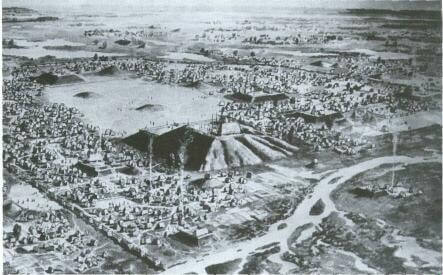
Cahokia Mound. The largest prehistoric artificial earthwork in the United States, situated in Madison County, Illinois, in what is known as the American bottom, about 6 miles East of St Louis, Missouri, and in plain view of the railroads entering that city from the East. Before their partial destruction by the plow the principal mound was surrounded by an extensive mound group, numbering, according to Brackenridge (Views La., 187, 1814), who visited the place in 1811, “45 mounds or pyramids, besides a great number of small artificial elevations.” The name Cahokia is that of a tribe which formerly occupied a neighboring village of the same name. In form the tumulus is a quadrangular pyramid with an apron, or terrace, extending from the south side. The dimensions as given by McAdams (Antiq. of Cahokia or Monk’s Mound, 2, 1883) are as follows: The base N. and S., 998 ft.; E. to W., 721 ft. ; height, 99 ft.; height of lower terrace, 30 ft.; outward extent of terrace about 200 ft.; width about 500 ft. The area of the base of the mound is estimated at about 16 acres. On the west side, some 30 ft. above the first terrace, there was a second slight terrace, now scarcely distinguishable. Patrick, who studied the mound and its surroundings, and prepared a model which was cast in iron ( now in the Peabody Museum at Cambridge, Mass.), represented a small level area or terrace some 3 or 4 ft. below the level top. Omitting the lower terrace and counting the diameters of the base as 721 and 798 ft., and the height as 99 ft., without regard to the upper level, the contents somewhat exceed 18,690,000 cu. ft. Adding the terrace, 3,000,000 cu. ft., the total contents amount to 21,690,000 cu. ft. The wall of Fort Ancient, Ohio, has been frequently referred to as one of the most extensive ancient works of the United States, yet the contents of the Cahokia mound would form a wall of the same base and height exceeding 17 in. in length, or more than five times the length of the wall, of Fort Ancient, and would have required, according to the usual method of calculation, the labor of 1,000 persons for 4½ years, with the means that prehistoric; Indians had at hand. The places from which the earth was taken are apparent from the depressions surrounding the Cahokia mound. In 1811, when visited by Brackenridge, the largest terrace was used by a colony of Trappists (whence sometimes the name Monk’s Mound) , who resided in several small cabins on one of the smaller mounds, which latter was cultivated as a kitchen garden.
Further Information on the Cahokia Mound:
- Brackenridge, op. cit.
- Bushnell, Cahokia and Surrounding Mound Group, Peabody Mus. Publ., 1904
- Conant, Footprints of Vanished Races, 1879
- McAdams, Records of Ancient Races, 1887
- McAdams, Antiquities of Cahokia, or Monk s Mound, 1883

